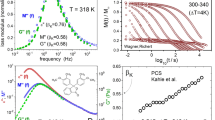Abstract
The electron spin-lattice relaxation times (T 1) of a variety of semiquinone ions in hydrogen bonding solvents have been measured by the pulsed saturation recovery technique as a function of temperature (T) and viscosity (η) of the solvent. Also linewidths (ΔH) have been measured in suitable cases in such solvents at low radical concentrations (∼10−4 M). It is observed that (i) the temperature and viscosity dependence ofT 1 can be fitted to an equation of the form 1/T 1=A(T/η)+Bexp(-ΔE/RT) whereA andB are constants and ΔE is an activation energy of the order of 1 kcal mole−1 for these systems; (ii)T 1 is essentially independent of the radical concentration within the range 10−3 to 5×10−2 M; (iii) the concentration independent part of the linewidth (ΔH) increases linearly with (η/T) at sufficiently low temperatures, and (iv) the (η/T) dependent part ofT 1 is sensitive to the size of the semiquinone as well as that of the solvent molecule, whereas the linewidth which is proportional to (η/T) at high viscosity, low temperature region is not sensitive to the size of the semiquinone and that of the solvent. Based on these observations, it is postulated that in hydrogen bonding solvents, three types of motion contribute significantly to electron spin relaxation:
-
(a)
A restricted small step diffusional motion, not involving large changes in the orientation of the molecule, leading to the dominant viscosity dependent contributions toT 1 and ΔH, due to spin rotation interaction;
-
(b)
a large amplitude reorientation of the semiquinone, coupled to translational diffusion, resulting in viscosity dependent contributions toT 1 and ΔH, throughg-modulation;
-
(c)
a hindred rotation of the semiquinone within the solvent cage, contributing toT 1 due to spin rotation interaction.
The fact thatT 1 is not sensitive to the concentration of the radicals, is ascribed to the formation of the solvent cage that prevents the close approach of radicals, thereby rendering radical-radical interactions to be weak mechanisms for relaxation, even at relatively high radical concentrations.
Similar content being viewed by others
References
Bloembergen N, Purcell E M and Pound R V 1948Phys. Rev. 73 679
Brown R J C, Gutowsky H S and Shimomura K 1963J. Chem. Phys. 38 76
Chandrasekhar S 1946Rev. Mod. Phys. 15 1
Connor H 1972 Ph.D. Thesis (Cornell University), p. 63
Debye P 1945Polar molecules (New York: Dover) p. 83
Eastman M P, Kooser R G, Das M R and Freed J H 1969J. Chem. Phys. 51 2690
Eyring H and Ree T 1958 “Relaxation Theory of Transport Phenomena” ch. 3, vol. 2,Rheology ed Frederick R Eirich (New York; Academic Press) p. 83
Frenkel J 1946Kinetic theory of Liquids (New York: Dover) p. 202
Gierer A and Wirtz K 1953Z. Naturforsch. 8 a 532
Handbook of chemistry and physics 1971 –72 52nd edition ed Robert C Weast (Ohio: Chemical Rubber Publishing Co.) p. F-37
Huang R and Kivelson D 1972Pure Appl. Chem. 32 207
Hubbard P S 1958Phys. Rev. 109 1153; 1963Phys. Rev. 131 1155
Ivanov E N 1963Zh. Eskp. Teor. Fiz. 45 1509
Khakhar M P, Prabhananda B S and Das M R 1966J. Chem. Phys. 45 2327
Kivelson D 1960J. Chem. Phys. 33 1049
Krishnamoorthy M V and Venkataraman B 1967Indian J. Pure Appl. Phys. 5 325
Leniart D S 1971 Ph.D. Thesis (Cornell University) p. 50
Lingam K V, Nair P G and Venkataraman B 1972Proc. Indian Acad. Sci. A 76 207
McConnell H M 1956J. Chem. Phys. 25 709
Nyberg G 1967Mol. Phys. 12 69
O’Reilly D E and Schacher G E 1963J. Chem. Phys. 39 1768 (Also see: O’Reilly D E 1968J. Chem. Phys. 49 5416; O’Reilly D E and Peterson E M 1971J. Chem. Phys. 55 2155; O’Reilly D E 1972J. Chem. Phys. 57 885)
Rengan S K, Khakhar M P, Prabhananda B S and Venkataraman B 1972a Pure Appl. Chem. 32 287; 1972b Proc. Nucl. Phys. Solid StatePhys. Symp. Bombay14 C 231
Schreurs J W H and Fraenkel G K 1960J. Chem. Phys. 34 756
Stephen M J and Fraenkel G K 1960J. Chem. Phys. 32 1435
Spernol A and Wirtz K 1953Z. Naturfosch. 8 a 522
Sutherland G B B M 1905Phil. Mag. 9 781
Timmermans J 1959The Physico-chemical constants of binary systems in concentrated solutions Vol.2 (New York: Interscience Publishers Inc.), p. 1114
Venkataraman B 1956 Ph.D. Thesis (Columbia University) p. 9
Zandstra P J 1964J. Chem. Phys. 41 3655
Author information
Authors and Affiliations
Rights and permissions
About this article
Cite this article
Rengan, S.K., Khakhar, M.P., Prabhananda, B.S. et al. Study of molecular motions in liquids by electron spin-lattice relaxation measurements, I: Semiquinone ions in hydrogen bonding solvents. Pramana - J. Phys 3, 95–121 (1974). https://doi.org/10.1007/BF02847118
Received:
Issue Date:
DOI: https://doi.org/10.1007/BF02847118




